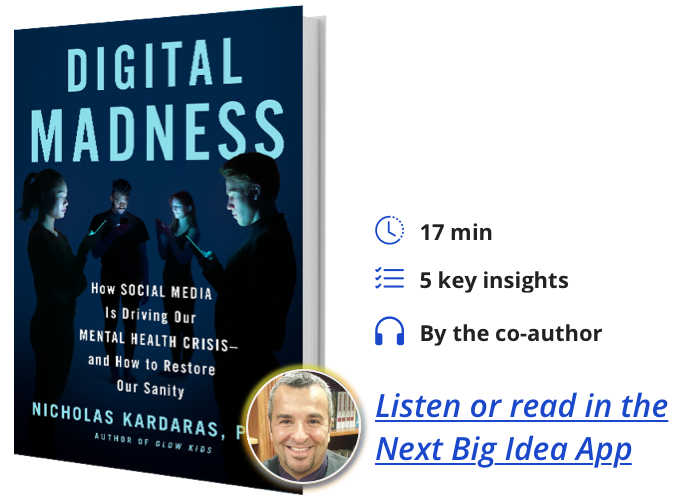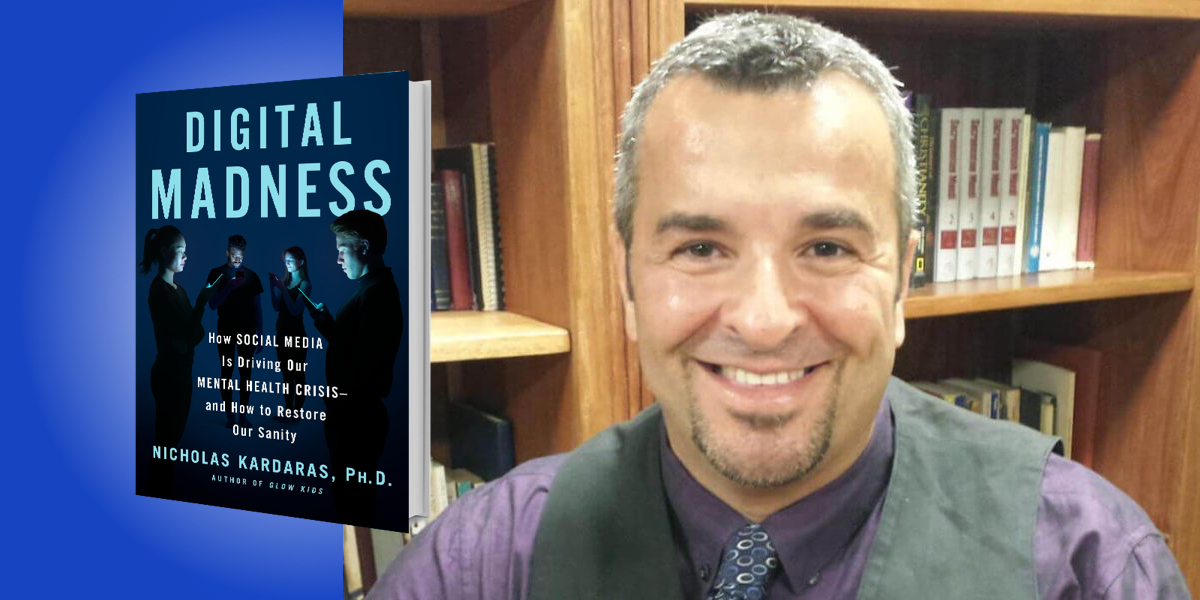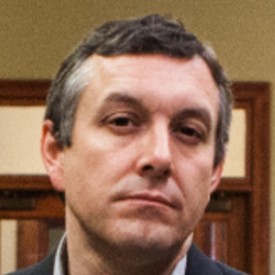Nicholas Kardaras is a psychologist and a former clinical professor at Stony Brook Medicine. He runs treatment programs all over the United States and is considered one of the country’s top thought leaders on the digital age and its impact on our mental health. His book Glow Kids, about the adverse effects of digital devices on kids, was released years before Gaming Disorder became acknowledged as an official diagnosis by the World Health Organization.
Below, Nicholas shares 5 key insights from his new book, Digital Madness: How Social Media is Driving Our Mental Health Crisis—And How to Restore Our Sanity. Listen to the audio version—read by Nicholas himself—in the Next Big Idea App.

1. High-tech lifestyles have outpaced our evolutionary development.
We’ve become a very sick society. While we lose ourselves in the digital diversion of Candy Crush, Instagram, and YouTube kitty videos, we’re dying in record numbers: more than 200,000 people (mostly young adults) died in the United States in 2019 from psychologically driven deaths of despair (suicide, overdose, and alcoholism). Add the record rates of loneliness, anxiety, depression, extremism, political unrest, and mass shootings and you have the telltale signs of a society on the brink.
The issue is that humans aren’t genetically designed for technologically driven twenty-first-century living. We aren’t meant to be sedentary, screen-staring, atomized, and meaning-devoid beings. Modern life is antithetical to our hunter-gatherer psychological needs. We’re hardwired for face-to-face community, genetically designed to be physically active, and psychologically primed to seek meaning. The digital age is kryptonite to those sanity-sustaining needs.
Research indicates that as we’ve become increasingly mad for our devices, our devices have driven us increasingly mad. This mismatch of technology and biological evolution has been disastrous for physical health. According to the CDC, obesity has increased by 70 percent over the last thirty years for adults and a staggering 85 percent for children. Diabetes has also been spiking; rates in adults have almost doubled over the last twenty years, and in teens and children, type 1 diabetes has increased by an average of 2 percent each year from 2002 to 2012.
Kids have been consuming fast food and sugary sodas for decades, but the new variable in the obese and diabetic child equation is an increase of screen time, and its attendant decrease in physical activity. This toxic tech lifestyle affects adults as well. This new sedentary version of Homo sapiens—Homo Can’t-Get-Off-the-Couch—has a soft, cushiony waistline expanding out like a freshly baked muffin top. Starvation used to kill millions. Now, the pendulum-swinging opposite—obesity, with its attendant heart attacks, diabetes, and high blood pressure—is killing more people than hunger.
Our magical digital age has given us smarter phones but dumber people. Several studies show how our memory, cognitive acuity, and physical health and fitness all suffer from a sedentary and tech-enabled lifestyle.
2. Depression is a disease of modernity.
In the blink of an evolutionary eye, we’ve gone from hunter-gatherer, sped past agrarian, leapfrogged over the industrial age, and gone from the steam engine to search engine. Yet, our psychological, social, and emotional needs are still genetically paleo. We need community, connection, physical activity, purpose, nature, and hope—all of which have been diminished or destroyed by Big Tech. This is why the longevity “Blue Zones” around the world tend to cluster in societies that share less modernized, pre-digital lifestyles.
“Imagine that—no iPhones, yet not a single member of the over two thousand Kaluli people studied showed signs of clinical depression.”
The Blue Zones author Dan Buettner identified common characteristics of societies where people tended to live longer and had a significantly higher number of centenarians. Those seemingly life-extending characteristics included regular physical activity, a sense of life purpose, stress reduction, moderate caloric intake, engagement in spiritual practice, and engagement in a strong family and social life. Are these characteristics enhanced or dampened by the products and platforms made by Apple, Microsoft, Facebook, Twitter, Amazon, and Google?
Similarly, Dr. Stephen Ilardi, a depression researcher at the University of Kansas, discovered that non-technological indigenous peoples were much healthier from a mental health standpoint. He discovered that so-called primitive cultures like the Kaluli in Papua New Guinea had zero instances of depression. Imagine that—no iPhones, yet not a single member of the over two thousand Kaluli people studied showed signs of clinical depression.
We all have the same basic genetic and neurological equipment, so why do “primitives” seem immune to the depression epidemic? A mental health disorder that, according to the World Health Organization (WHO), is the number one chronic and debilitating illness in the world. And keep in mind that the Kaluli lived challenging lives where daily survival was a struggle. Yet we “moderns” have the highest rates of depression despite living in relative comfort and throwing copious antidepressants at the problem.
According to Dr. Ilardi, increased rates of depression are a by-product of modernized lifestyles: “We’ve been engineering the activity out of our lives. The levels of bright-light exposure—time spent outdoors—have been declining. The average adult gets just over six and a half hours of sleep a night. It used to be nine hours a night. There’s increasing isolation, fragmentation, the erosion of community…we feel perpetually stressed. And the more we learn about depression neurologically, the more we learn that it represents the brain’s runaway stress response.” Ilardi also notes, “Americans are 10 times more likely to have depressive illness than they were 60 years ago . . . the rate of depression has more than doubled in just the past decade.” These numbers have increased during the isolation and screen dependence of the COVID pandemic.
3. Social media shapes minds.
After writing about tech addiction in Glow Kids, I noticed other disconcerting trends. First, in my clinics, more young clients were unable to cope with daily stressors. Many seemed reactive, angry, lonely, empty, confused, depressed, self-medicating, and generally had difficulty thriving. They almost all saw things in absolutes: black or white; love or hate; winner or loser.
This looked much like broader society, with its political polarization and highly reactive people that seem unable to critically think. In fact, an entire generation of reactive and binary young adults was meeting the clinical criteria of Borderline Personality Disorder—which is typified by emotional volatility and binary thinking.
But why are these issues spreading like a contagion now? Technology and social media have primed young people towards increased impulsivity and fragility, making them less resilient and shaping them into polarized, non-nuanced thinkers.
“Polarities are inextricably embedded into the platform’s genome and don’t allow for non-binary choices.”
Facebook itself was born as a binary choice of “Hot or Not” (now it’s “Like” or “Unlike”). Polarities are inextricably embedded into the platform’s genome and don’t allow for non-binary choices. Social media platforms act as self-reinforcing sorting mechanisms that are binary in nature, sending algorithmically fueled content to the user based on their perceived preferences, thus widening the polarity chasm.
As digital media has swallowed our world, it has transformed our brains into inherently limiting binary sorting machines that lack breadth and complexity—what’s known as spectrum thinking. Marshall McLuhan famously said in the 1960s, “the medium is the message,” except now the medium (digital, binary, social media) is not just the message, it also shapes the mind of the person receiving the message.
4. Digital social contagion effects.
In January of 2007, a strange phenomenon occurred in Bridgend, South Wales: young people started hanging themselves. By December of 2008, a total of 26 (mostly teenagers) had taken their own lives in the small traditional Welsh community. Although rare, suicide clusters are considered a classic social contagion effect—that is, any effect or behavior that spreads by social groups or is shaped by media. For example, smoking is a social contagion, spread by peers and impacted by marketing campaigns.
The type of suicide social contagion that occurred in Bridgend, Wales has also been called the Werther effect, named after Goethe’s novel The Sorrows of Young Werther. That novel, published in 1774, narrated the story of a young, sensitive, and passionate artist named Werther who gets involved in a tragic love triangle and ultimately commits suicide. The novel became an instant sensation, with a lethal effect: young men throughout Europe started dressing like Werther and committing suicide in what became known as Werther fever. They found a deep resonance with Werther’s pain and were emboldened by this fictitious character to take their own lives. The problem became so severe that the book was banned in Italy and Denmark.
Young men were influenced to end their lives by a fictitious character in a book. So, imagine the power of social media and viral influencers, where followers and views are the coin of the realm and extreme content attracts attention.
“These disorders are injected into our collective consciousness via popular influencers with hundreds of millions of views.”
That’s why the most over-the-top content and influencers attract followers like moths to a digital flame. It’s also why we’re seeing dramatic spikes in once-rare disorders like Tourette Syndrome, Dissociative Identity Disorder (DID, formerly known as Multiple Personality Disorder) and Borderline Personality Disorder (BPD). These disorders are injected into our collective consciousness via popular influencers with hundreds of millions of views. Their young followers begin to emulate the psychiatric symptoms of their mentally unwell social media darlings.
Of course, there are other lethal variants of digital social contagion effects—like school shooters and the Incel movement. The 1999 Columbine shooting was the first—such events had been almost unheard of. But since then, they have become a horrible part of daily life. Even the FBI acknowledges that these are Internet-fueled copycat events that spawn on social media and hate-filled chat rooms that incite the unstable.
5. The antidote to the toxic social media age.
Immunizing against the viral toxic effects of social media requires focusing less on the toxin (social media) and more on strengthening one’s psychological immune system. Essentially, become a modern Philosopher-Warrior with the grit and resilience of a Spartan and the critical thinking, curiosity, and intellect of an ancient philosopher. Here’s how:
- Build grit and resilience. According to psychologist Angela Duckworth (author of Grit), we develop grit by leaning into experiences, and thus allowing ourselves to make mistakes that we can learn from—and we never quit.
- Find a purpose that resonates with you. Mythologist Joseph Campbell said, “Find your bliss.” With purpose come passion and a clarity of one’s identity and place in the world—and thus we become less likely to be sucked into influencer nonsense.
- Maintain a physical practice. Healthy body, healthy mind. Keep yourself moving—it’s the best anti-depressant. Exercise raises endorphin levels, creates a sense of accomplishment, and keeps the mind sharp—thus immunizing it from toxic social media.
- Read classical philosophy. Ancient wisdom has a time-tested transcendent quality that elevates a person—and doesn’t debase and weaken the reader like superficial posts. The ancients teach the sanity-sustaining skill of critical thinking.
- Help others. The modern digital world creates egocentric narcissism as algorithms curate me-centrism. Break that pattern by focusing on helping others—volunteer, mentor or simply be kind to a neighbor. Manifesting altruism is the antidote to shallow values.
- Be creative. Be bored. Find opportunities to channel your creative self. Creativity is the antidote to groupthink. When not creating, give yourself permission to be bored and daydream. After all, boredom is the handmaiden of creativity. When we’re perpetually information over-loaded, there is no space for the mind to roam and be curious—critical ingredients in feeling self-actualized and not media-dependent.
To listen to the audio version read by author Nicholas Kardaras, download the Next Big Idea App today:































